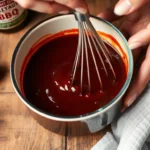We’re about to transform your grilling game with an authentic Japanese BBQ sauce that’ll make your taste buds dance. This umami-packed sauce combines the perfect balance of sweet, salty and savory flavors that Japanese cuisine is famous for. Unlike traditional American BBQ sauces, this version features ingredients like miso, mirin and soy sauce that create layers of complex flavor.
What makes this sauce truly special is its versatility – it’s not just for grilling. We use it as a marinade for chicken and beef, a glaze for vegetables, and even a dipping sauce for dumplings. The rich, glossy finish it creates on grilled meats is absolutely stunning.
The best part? You can whip this up in just 15 minutes using ingredients you’ll find at most grocery stores. Once you try this homemade version, you’ll never go back to store-bought again.
Ingredients
Creating this exceptional Japanese BBQ sauce requires carefully selected ingredients that work together to build layers of complex flavor. We’ve organized these components into three categories to help you understand how each element contributes to the final taste profile.
Main Sauce Base
- ½ cup soy sauce (low sodium preferred)
- ¼ cup rice wine vinegar
- 2 tablespoons sake or dry white wine
- 1 tablespoon sesame oil
- 2 cloves garlic, minced
- 1 teaspoon fresh ginger, grated
- 1 green onion, finely chopped
Sweet and Umami Components
- 3 tablespoons brown sugar
- 2 tablespoons honey
- 1 tablespoon miso paste (white or red)
- 1 teaspoon tomato paste
- 1 tablespoon cornstarch
- 2 tablespoons water (for cornstarch slurry)
Optional Flavor Enhancers
- 1 teaspoon toasted sesame seeds
- ½ teaspoon red pepper flakes
- 1 teaspoon rice mirin
- ¼ teaspoon ground black pepper
- 1 teaspoon oyster sauce (for deeper umami)
Equipment Needed
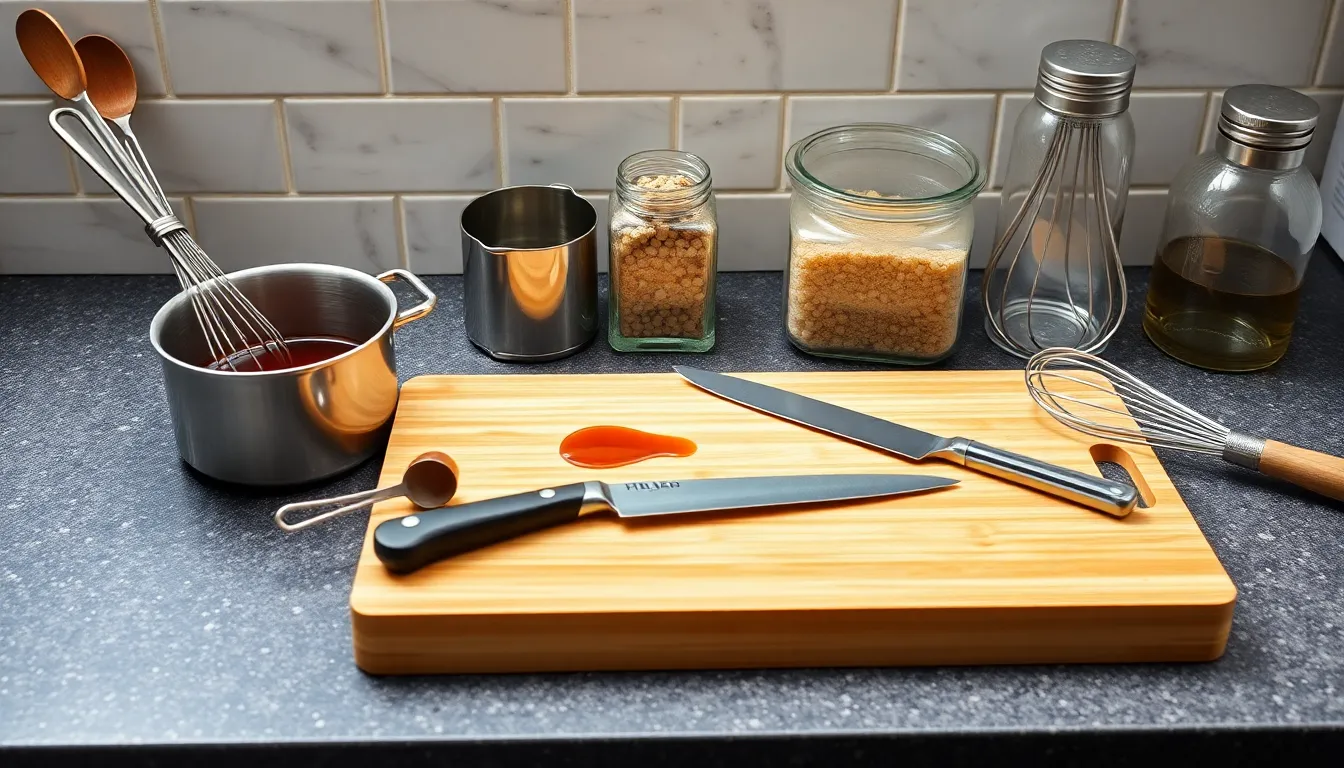
Creating our authentic Japanese BBQ sauce requires minimal yet essential kitchen tools that most home cooks already have on hand. We’ll walk through each piece of equipment and explain why it’s crucial for achieving the perfect sauce consistency and flavor balance.
Measuring spoons serve as the foundation of our recipe success. Precise measurements ensure we achieve the delicate balance between sweet mirin, salty soy sauce, and aromatic seasonings that define exceptional yakiniku sauce.
A small saucepan becomes our primary cooking vessel for heating and blending flavors together. We recommend using a heavy-bottomed pan to prevent scorching while we gently simmer the sake and mirin to cook off the alcohol.
Sharp knife and cutting board are essential for properly mincing garlic and chopping green onions to release maximum flavor. Fresh aromatics provide significantly better taste than pre-packaged alternatives.
A fine grater allows us to create smooth ginger paste and grated onion that integrate seamlessly into our sauce base. We prefer microplane graters for achieving the finest texture without fibrous chunks.
Whisk or wooden spoon helps us thoroughly combine ingredients and prevent the honey and sugar from settling at the bottom of the pan. Consistent stirring ensures even heat distribution and smooth sauce development.
A can opener becomes necessary when incorporating tomato paste or any canned ingredients that add depth to our umami profile. Quality tools make ingredient preparation more efficient.
Storage containers such as clean glass jars or airtight bottles preserve our homemade sauce for weeks in the refrigerator. We recommend sterilized containers to maintain freshness and prevent contamination.
An optional fine mesh strainer can smooth out any remaining lumps from garlic paste or ginger, creating restaurant-quality consistency. This step elevates the final presentation when serving guests.
Instructions

We’ll walk through each step to create this authentic Japanese BBQ sauce that brings restaurant-quality flavor to your home kitchen. Our method ensures perfect balance between sweet and savory elements while building layers of umami depth.
Prep the Ingredients
Start by measuring out 1/4 to 1/2 cup soy sauce depending on your preferred saltiness level. Add 2 to 3 tablespoons of sugar to a small bowl for easy incorporation. Measure 2 tablespoons of mirin to provide that essential sweet rice wine flavor.
Grate 1 teaspoon of fresh ginger using your fine grater until you achieve a smooth paste consistency. Freshly grate 1 teaspoon of garlic using the same technique. Measure 1/2 tablespoon of whole sesame seeds and 1/2 tablespoon of sesame oil.
Prepare any optional ingredients you’ve chosen such as 2 dried chili peppers, 1-2 teaspoons of tomato paste, chopped green onions, or 1 teaspoon of rice vinegar. Having everything measured beforehand ensures smooth cooking without interruption.
Combine the Base Ingredients
Place the soy sauce, sugar, and mirin into your small saucepan. Add the freshly grated ginger and garlic to the mixture. Incorporate the sesame seeds at this stage to allow them to release their nutty oils during cooking.
Add any optional ingredients like dried chili peppers or tomato paste to the pot now. Whisk all ingredients together until the mixture appears well combined and the sugar begins to dissolve. The mixture should have a rich brown color with visible sesame seeds distributed throughout.
Simmer and Reduce
Bring the mixture to a rolling boil over medium heat while stirring occasionally. Once boiling, reduce the heat to low to maintain a gentle simmer. Allow the sauce to cook for exactly 5 minutes, stirring every minute to prevent sticking.
Watch as the sugar dissolves completely and the flavors begin to meld together. The sauce will start to thicken slightly and develop a glossy appearance. Remove the saucepan from heat after the 5-minute mark to prevent overcooking.
Adjust Seasoning to Taste
Stir in the sesame oil immediately after removing from heat to preserve its delicate aroma and flavor. Taste the cooled sauce using a clean spoon to assess the flavor balance. Add more sugar if you prefer increased sweetness, or incorporate additional soy sauce for deeper umami notes.
Include rice vinegar one teaspoon at a time if you desire more acidity to brighten the overall flavor profile. Allow the sauce to cool completely before final seasoning adjustments, as flavors intensify as the temperature drops. Store any remaining sauce in your prepared containers for future use.
Cooking Tips and Techniques
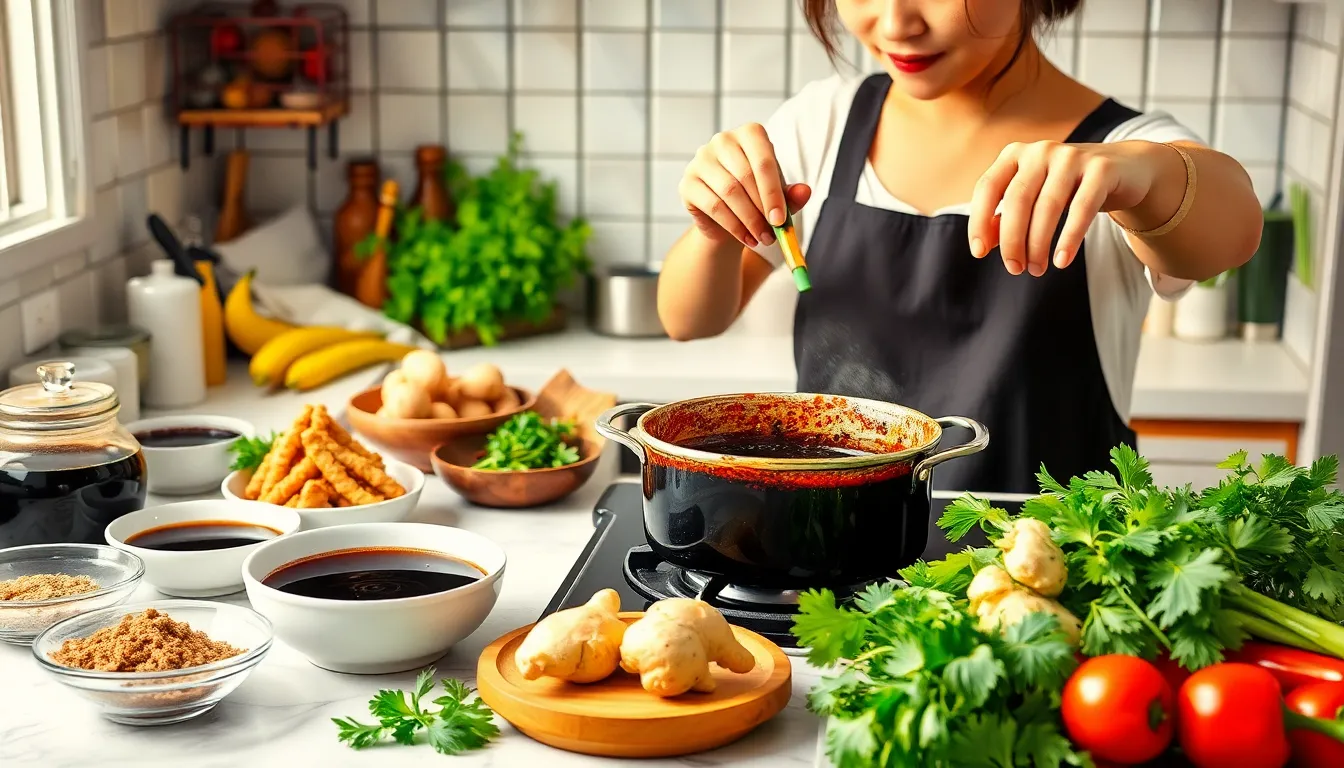
Mastering Japanese BBQ sauce requires understanding key techniques that elevate your homemade version beyond store-bought alternatives. These essential methods ensure your sauce achieves the perfect balance of flavors and texture every time.
Achieving the Perfect Consistency
The ideal Japanese BBQ sauce maintains a pourable yet slightly viscous texture that clings beautifully to meats and vegetables. We recommend gently heating your sauce mixture while stirring continuously to dissolve the sugar completely and reduce excess liquid naturally. This process creates the balanced viscosity that makes the sauce perfect for both dipping and glazing.
If your sauce becomes too thick during cooking, simply adjust by adding small amounts of water or mirin until you reach the desired consistency. Conversely, if the mixture appears too thin, increase the sugar or soy sauce content to thicken and intensify the overall flavor profile. The key lies in making these adjustments gradually while the sauce is still warm, as it will thicken slightly as it cools.
Using a blender or whisk ensures even distribution of all ingredients and creates that unified texture we’re aiming for. We find that heating the sauce gently prevents burning while allowing all components to meld together seamlessly.
Balancing Sweet and Savory Flavors
Creating the perfect harmony between sweet and savory elements defines authentic Japanese BBQ sauce. We achieve sweetness primarily through brown sugar, honey, mirin, and sometimes grated fruits like apple, which provide natural sugars and remarkable depth of flavor.
Savory notes emerge from soy sauce, minced garlic, fresh ginger, and occasionally miso paste or a touch of Worcestershire sauce for added umami complexity. These ingredients work together to create that distinctive Japanese flavor profile that makes this sauce so irresistible.
Rice vinegar plays a crucial role in balancing the overall taste by adding brightness that prevents the sauce from becoming overwhelmingly sweet. We recommend starting with small amounts and tasting frequently, as this acidic component can dramatically transform the final result.
Grating fresh ingredients like onion, garlic, and ginger finely releases their natural juices, which intensify the flavor and help achieve that perfect sweet and savory balance. Optional heat elements such as red pepper flakes or a small amount of chili paste can add subtle spice that complements and contrasts beautifully with the sweetness.
Remember to store your finished sauce refrigerated and use within 1 to 2 weeks to maintain optimal freshness and flavor intensity.
Storage Instructions
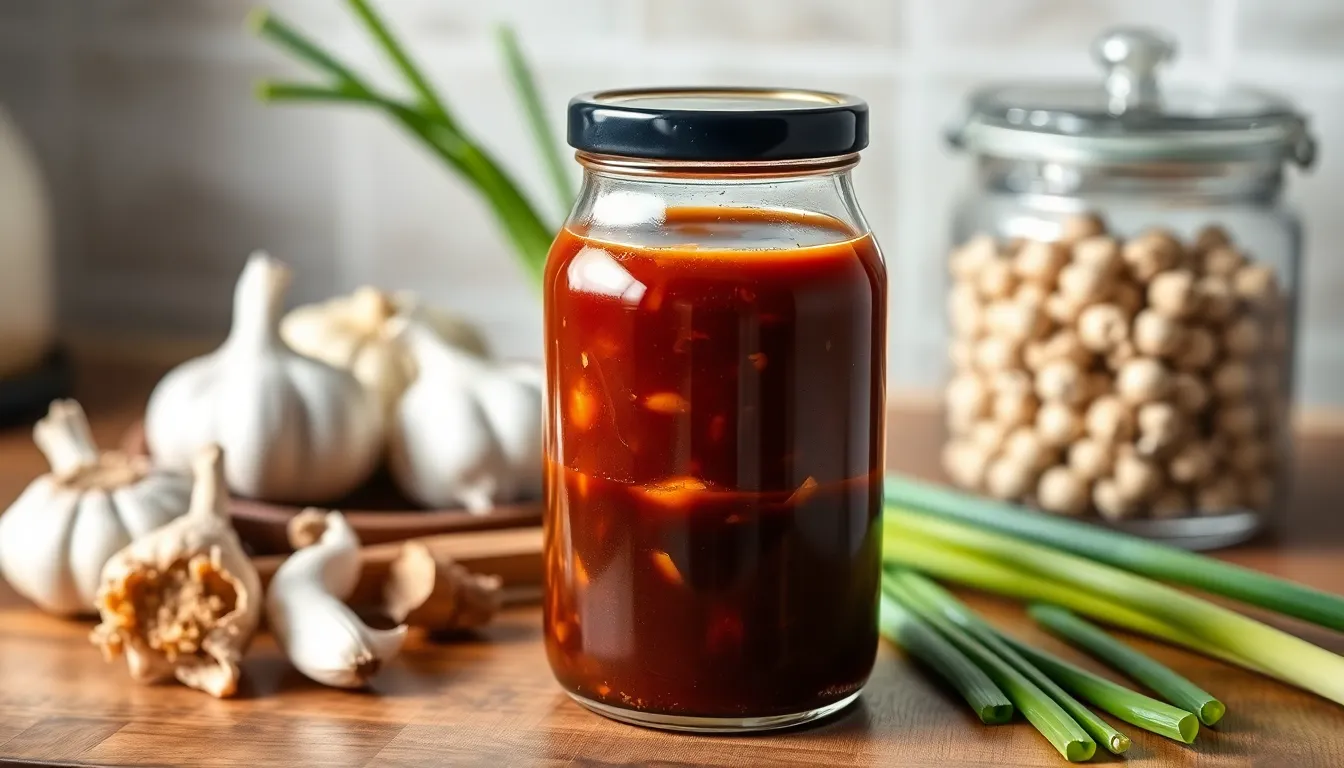
We’ve crafted this exceptional Japanese BBQ sauce to last well beyond a single grilling session. Proper storage techniques ensure our homemade sauce maintains its rich umami flavor and glossy texture for weeks to come.
Refrigerator Storage
We recommend transferring our cooled Japanese BBQ sauce into an airtight container before refrigerating. Glass jars or sealed plastic containers work perfectly to preserve the sauce’s complex flavor profile while preventing contamination from other refrigerator odors.
Our homemade sauce stays fresh in the refrigerator for up to 2 weeks when stored properly. We always label our containers with the preparation date to track freshness and ensure optimal flavor quality.
Before each use we gently stir the chilled sauce to recombine any ingredients that may have separated during storage. The cold temperature might thicken the consistency slightly but warming it gently on the stove or in the microwave restores its perfect pourable texture.
Freezer Options
We freeze our Japanese BBQ sauce in small portions using ice cube trays for convenient single-serving portions. This method allows us to thaw only what we need while keeping the remaining sauce frozen for future grilling sessions.
Our sauce maintains its exceptional quality in the freezer for up to 3 months without losing its signature sweet and savory balance. We transfer the frozen cubes into labeled freezer bags once solid to prevent freezer burn and save space.
When ready to use we thaw the frozen sauce cubes in the refrigerator overnight or warm them gently on the stovetop. We stir the thawed sauce thoroughly to restore its smooth consistency as some separation naturally occurs during the freezing process.
Serving Suggestions
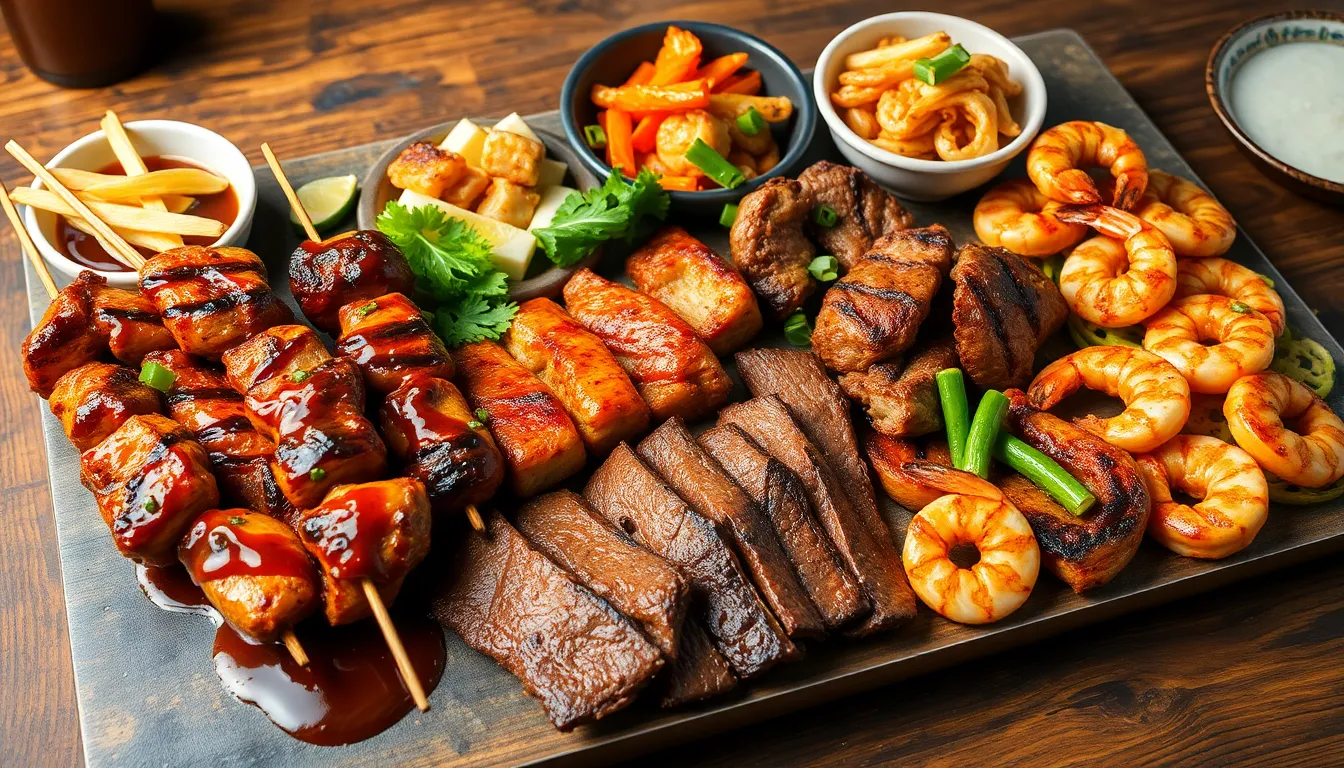
Our Japanese BBQ sauce transforms any meal into an authentic culinary experience with its rich umami profile. This versatile condiment works beautifully as both a dipping sauce and finishing glaze across countless dishes.
Best Proteins to Pair With
Beef stands out as the premier choice for our Japanese BBQ sauce, particularly when using thinly sliced cuts perfect for yakiniku-style grilling. The sauce’s savory depth complements the meat’s natural richness while adding layers of complex flavor.
Pork creates another exceptional pairing, whether we’re preparing crispy tonkatsu or succulent grilled pork belly. The sauce’s balanced sweetness cuts through the meat’s richness while improving its savory qualities.
Chicken benefits tremendously from our sauce, especially when preparing grilled skewers or traditional yakitori. The umami components penetrate the meat while the slight acidity brightens each bite.
Seafood options like grilled shrimp or fish showcase the sauce’s versatility beyond traditional meat applications. The delicate balance of sweet and savory elements enhances without overwhelming the natural flavors of the seafood.
Grilling Applications
We recommend using our sauce as a marinade before grilling to infuse deep flavor throughout the meat. Allow proteins to marinate for at least 30 minutes to maximize flavor penetration.
Applying the sauce as a finishing glaze during the final stages of grilling creates a beautiful caramelized coating. The natural sugars in the sauce caramelize beautifully over direct heat, creating an appetizing glossy finish.
Serving the sauce alongside grilled meats as a dipping condiment allows diners to control their flavor intensity. This approach works particularly well for family-style dining or entertaining guests.
Other Creative Uses
Drizzling our Japanese BBQ sauce over stir-fried vegetables or noodles instantly elevates simple dishes with authentic Asian flavors. The sauce coats ingredients evenly while adding savory depth.
Mixing the sauce into salad dressings creates an Asian-inspired flavor twist that transforms ordinary greens into exciting side dishes. Start with small amounts and adjust to taste preferences.
Using our sauce as a dipping condiment for fried appetizers like tempura or spring rolls provides guests with an authentic Japanese dining experience. The sauce’s balanced acidity cuts through rich, fried foods perfectly.
Recipe Variations
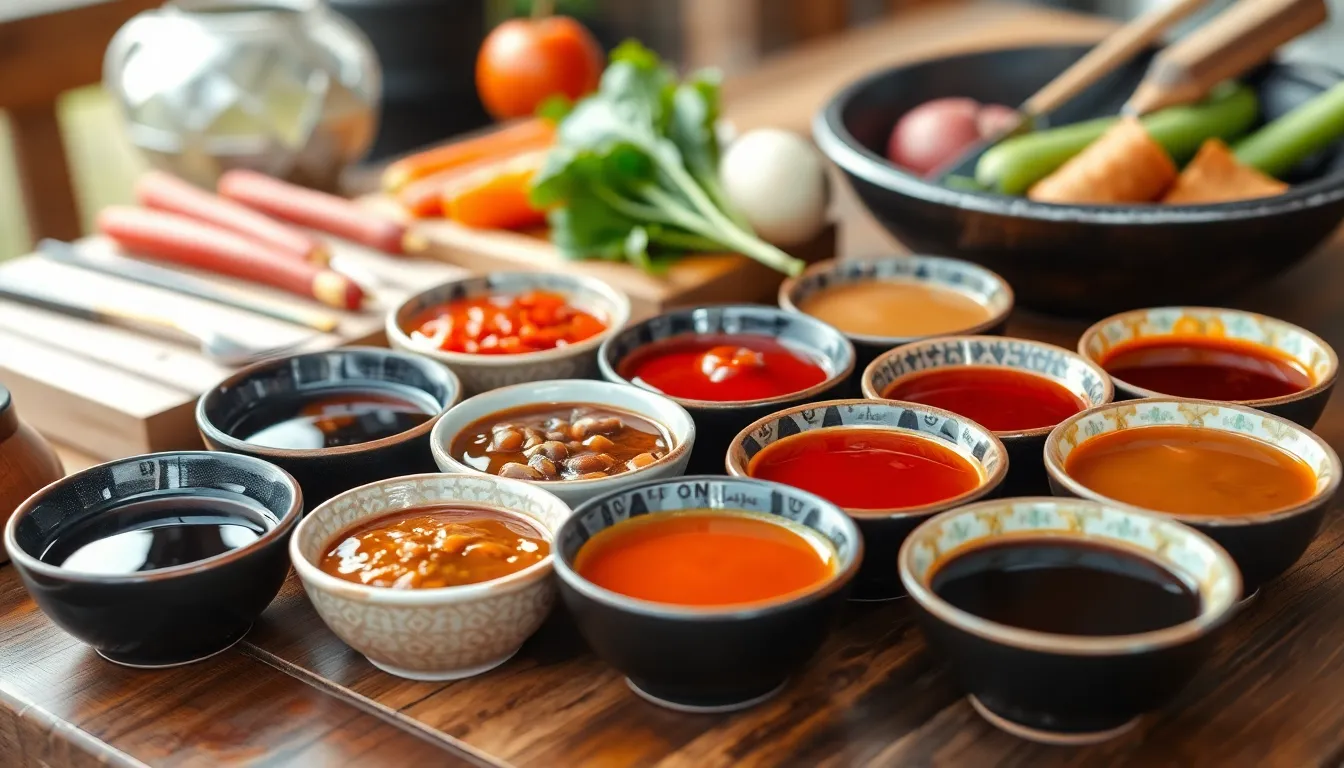
We can easily customize our Japanese BBQ sauce to match different taste preferences or dietary needs. These variations maintain the authentic umami foundation while adding unique flavor profiles.
Spicy Japanese BBQ Sauce
We transform our base sauce into a fiery version by incorporating heat-building ingredients that complement the sweet and savory profile. Adding 1-2 teaspoons of chili paste creates immediate warmth while maintaining the sauce’s smooth texture. Shichimi togarashi offers a complex spicy element with its seven-spice blend that includes chili peppers and sesame seeds.
Fresh chopped chili peppers provide customizable heat levels depending on our spice tolerance. We recommend starting with one small jalapeño or serrano pepper and adjusting from there. The capsaicin from these peppers enhances the umami depth rather than overwhelming it.
We maintain the sauce’s balance by keeping all other ingredients proportional to the original recipe. The heat should build gradually rather than hitting immediately for the most authentic Japanese flavor experience.
Miso-Enhanced Version
We elevate our BBQ sauce by whisking in 1-2 tablespoons of miso paste for added fermented complexity. White miso creates a milder enhancement while red miso delivers deeper savory notes. The paste must be whisked thoroughly until completely smooth to prevent lumps.
Miso naturally thickens our sauce while contributing beneficial probiotics and minerals. We find that this variation pairs exceptionally well with grilled vegetables and tofu due to its enhanced umami profile. The fermented soybeans in miso create layers of flavor that develop further as the sauce simmers.
This version stores particularly well and actually improves in flavor after 24 hours as the miso continues to meld with other ingredients. We recommend preparing this variation a day ahead for optimal taste development.
Low-Sodium Alternative
We create a heart-healthy version using low-sodium tamari or reduced-sodium soy sauce as our foundation. This substitution reduces sodium content by approximately 25-40% while maintaining the essential soy flavor profile.
Natural sweeteners replace refined sugar in this variation. We use 2 tablespoons of honey or 3 pitted dates blended with water to create a paste. These alternatives provide minerals and fiber while delivering the necessary sweetness to balance the sauce.
| Ingredient Substitution | Original Amount | Low-Sodium Amount |
|---|---|---|
| Soy Sauce | 1/2 cup regular | 4 tablespoons low-sodium tamari |
| Sugar | 1/2 cup | 2 tablespoons honey |
| Water | 1/2 cup | 3 tablespoons |
| Mirin | 2 tablespoons | 2 tablespoons |
We simmer this version for an additional 2-3 minutes to concentrate flavors since we use less liquid overall. The reduced sodium content allows the other ingredients like ginger and garlic to shine more prominently.
Make-Ahead Instructions
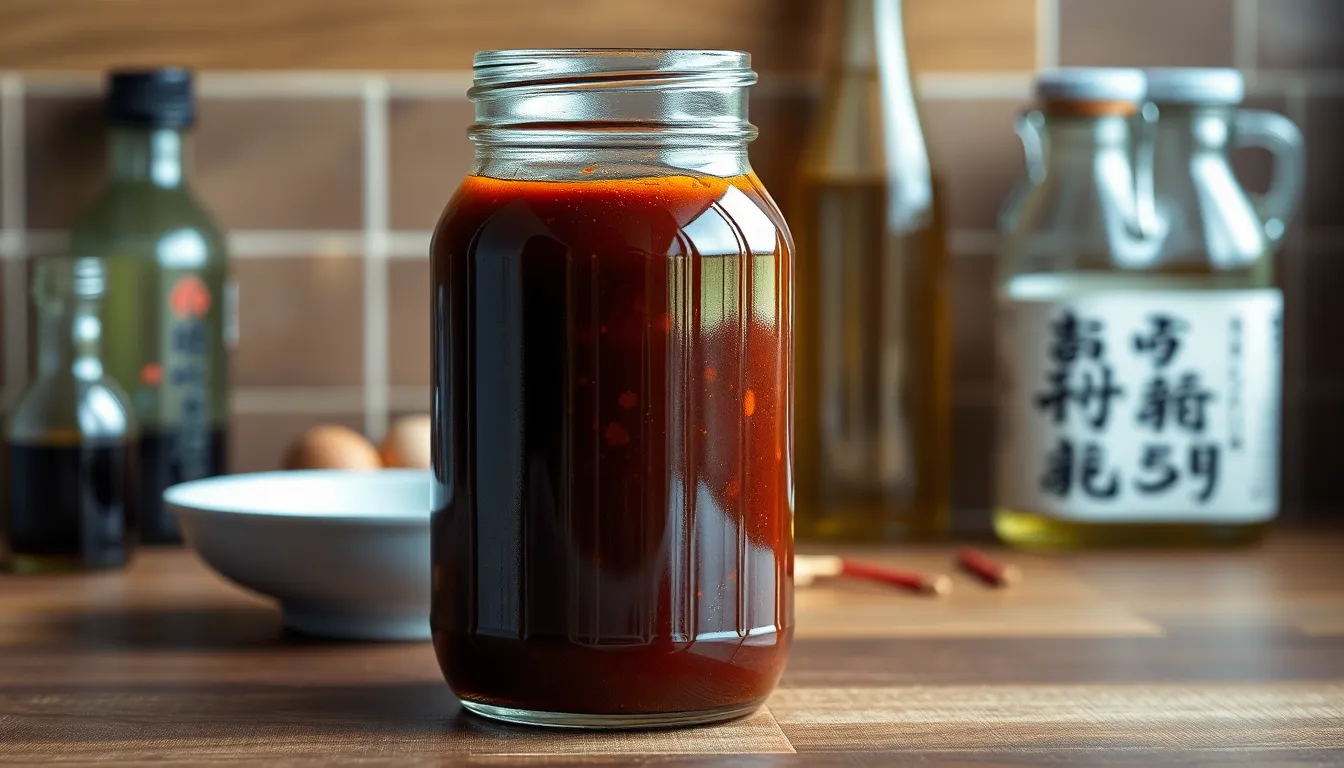
We recommend preparing our Japanese BBQ sauce in advance to allow the flavors to fully develop and meld together. Making the sauce ahead of time actually improves its taste as the ingredients have more time to harmonize.
Store your freshly made sauce in an airtight container in the refrigerator immediately after it cools to room temperature. Most homemade versions will keep well for up to two weeks when properly stored. Some sources indicate that with proper storage techniques the shelf life can extend to one month.
| Storage Method | Duration | Notes |
|---|---|---|
| Refrigerated (airtight container) | Up to 2 weeks | Standard storage recommendation |
| Refrigerated (proper storage) | Up to 1 month | With optimal storage conditions |
| Freezing | Not recommended | High sugar content alters texture |
Always use clean utensils when handling the sauce to maintain freshness and prevent contamination. Label your storage container with the preparation date so you can track how long the sauce has been stored.
We do not recommend freezing this sauce due to its high sugar content which can significantly alter the texture when thawed. The consistency may become grainy or separate after freezing and thawing.
Before using refrigerated sauce let it come to room temperature for the best flavor and consistency. You can also gently warm it in a small saucepan over low heat while stirring to restore its original texture and enhance the aromatic qualities.
Troubleshooting Common Issues
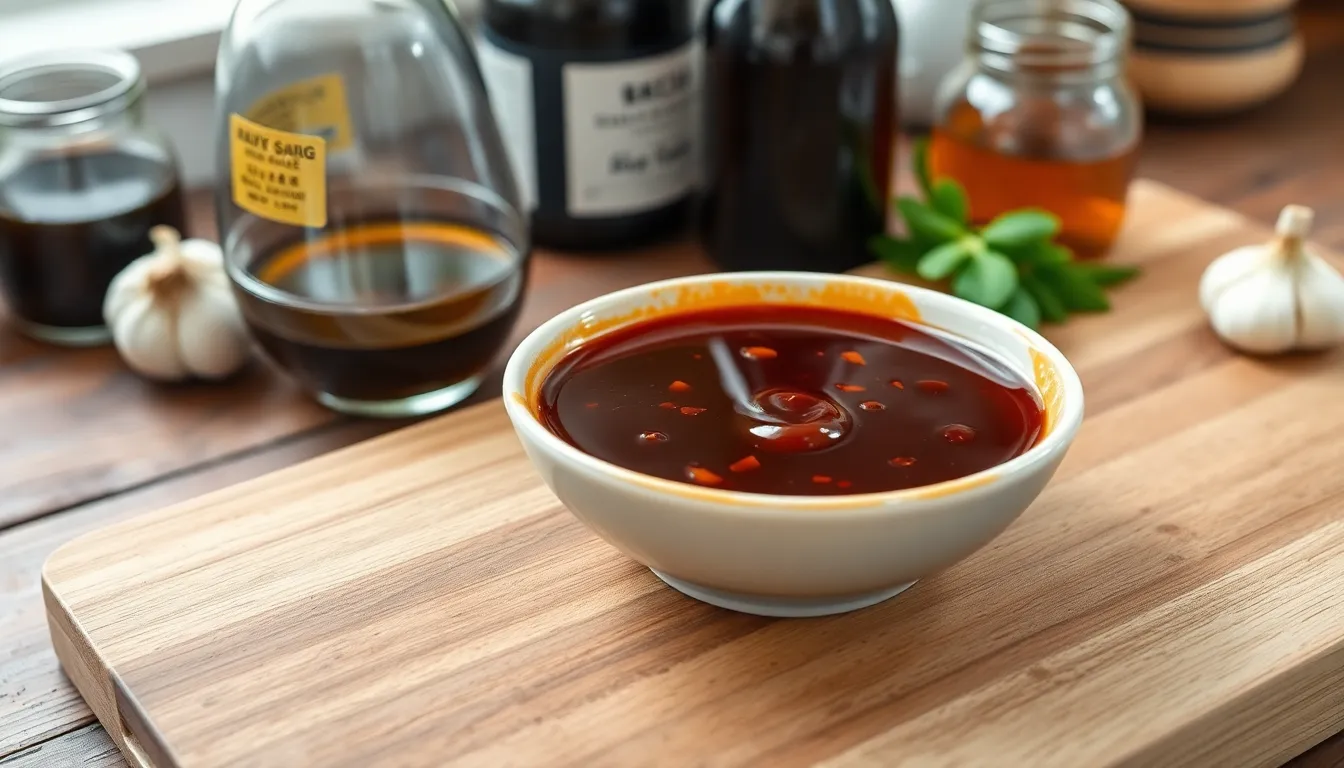
Even experienced home cooks occasionally encounter challenges when preparing Japanese BBQ sauce. We’ve identified the most frequent problems and their answers to help you achieve perfect results every time.
Sauce Turns Out Too Salty
Excessive saltiness typically stems from using regular soy sauce instead of low-sodium varieties. We recommend switching to low-sodium soy sauce as your primary solution. Add water or rice vinegar slowly while tasting to gradually balance the saltiness without diluting the overall flavor profile. Start with one teaspoon increments to avoid overcorrecting the seasoning.
Mixture Becomes Too Thick
Thick sauce often results from over-reducing during the heating process or using too much tomato paste. Add water or mirin gradually while gently heating the sauce to reach your desired consistency. We suggest adding liquid one tablespoon at a time while stirring continuously to prevent flavor loss. This method maintains the sauce’s integrity while achieving the proper texture.
Overly Sweet Results
Excessive sweetness usually occurs when using too much brown sugar or mirin. Reduce these ingredients in your next batch or add rice vinegar to create better balance. Substituting brown sugar for white sugar can help moderate sweetness levels. We find that adding small amounts of soy sauce can counteract excessive sweetness effectively.
Lumpy or Grainy Texture
Lumps typically form when grated ginger pieces or minced garlic chunks remain in the final product. Strain your sauce carefully through a fine mesh strainer to remove all solid particles. We recommend pressing the mixture through the strainer with a spoon to extract maximum flavor while achieving restaurant-quality smoothness.
Weak or Unbalanced Flavor
Bland sauce results from improper ingredient ratios or insufficient cooking time. Ensure proper balance between soy sauce, rice vinegar, and mirin components. Simmer the mixture gently for adequate time to allow flavors to blend fully. We suggest tasting throughout the cooking process and adjusting seasonings before the sauce cools completely.
| Common Issue | Primary Cause | Solution |
|---|---|---|
| Too Salty | Regular soy sauce used | Switch to low-sodium variety |
| Too Thick | Over-reduction | Add water/mirin gradually |
| Too Sweet | Excess sugar/mirin | Reduce sweet ingredients |
| Lumpy Texture | Solid particles remain | Strain through fine mesh |
| Weak Flavor | Poor ratios/insufficient cooking | Balance ingredients and simmer longer |
Adjusting ingredient ratios carefully and controlling heat during preparation ensures consistent results. We find that most issues resolve by making small adjustments rather than starting over completely.
Conclusion
This Japanese BBQ sauce recipe delivers restaurant-quality results that’ll transform your grilling game. We’ve shown you how simple ingredients can create complex umami flavors that work beautifully with everything from beef to vegetables.
The 15-minute preparation time makes this sauce accessible for weeknight dinners or weekend barbecues. With proper storage techniques you’ll always have this versatile condiment ready to elevate your meals.
Whether you stick to our base recipe or experiment with the spicy and miso variations we’ve shared this sauce will become your go-to secret weapon. Your guests will definitely be asking for the recipe after their first taste.
Frequently Asked Questions
What makes this Japanese BBQ sauce different from store-bought versions?
This homemade Japanese BBQ sauce offers a superior umami flavor profile that combines sweet, salty, and savory elements. Unlike store-bought options, it uses fresh ingredients like garlic, ginger, and miso paste, creating a rich, glossy finish. The sauce can be customized to your taste preferences and contains no artificial preservatives, making it healthier and more flavorful than commercial alternatives.
How long does it take to make this Japanese BBQ sauce?
The sauce takes only 15 minutes to prepare from start to finish. This includes measuring and prepping ingredients (5 minutes), combining and simmering the mixture (8-10 minutes), and final seasoning adjustments (2 minutes). The quick preparation time makes it perfect for weeknight grilling or last-minute meal planning.
What are the essential ingredients needed for this sauce?
The main ingredients include soy sauce, rice wine vinegar, sake, sesame oil, garlic, ginger, and green onion for the base. Sweet and umami components consist of brown sugar, honey, miso paste, tomato paste, cornstarch, and water. Optional flavor enhancers like toasted sesame seeds, red pepper flakes, and oyster sauce can be added for extra depth.
How should I store the Japanese BBQ sauce and how long does it last?
Store the sauce in an airtight container in the refrigerator for up to 2 weeks. Always label containers with the preparation date for freshness tracking. For longer storage, freeze the sauce in small portions, though this may slightly change the texture. Keep refrigerated and use a clean spoon when serving to maintain quality.
What foods pair best with this Japanese BBQ sauce?
This versatile sauce pairs excellently with beef, pork, chicken, and seafood. Use it as a marinade for 30 minutes before grilling, brush it on as a finishing glaze during the last few minutes of cooking, or serve as a dipping sauce. It also works well with grilled vegetables and dumplings, making it incredibly versatile.
Can I adjust the flavor if my sauce doesn’t taste right?
Yes, most flavor issues can be easily fixed. If too salty, switch to low-sodium soy sauce or add honey. If too thick, gradually add water or sake. If too sweet, increase soy sauce or vinegar. For lumpy texture, strain the sauce. For weak flavor, ensure proper ingredient ratios and adequate simmering time.
What kitchen equipment do I need to make this sauce?
Essential equipment includes precise measuring spoons, a small saucepan for heating, a sharp knife and cutting board for prep work, and a whisk or wooden spoon for mixing. A fine grater helps create smooth ginger paste, while a can opener is needed for tomato paste. An optional fine mesh strainer creates restaurant-quality smoothness.
Can I make variations of this Japanese BBQ sauce?
Absolutely! Create a spicy version by adding extra red pepper flakes or sriracha. Make a miso-enhanced version with additional miso paste for deeper umami. For a low-sodium alternative, use reduced-sodium soy sauce and increase other seasonings. These variations allow you to customize the sauce to your specific taste preferences and dietary needs.


